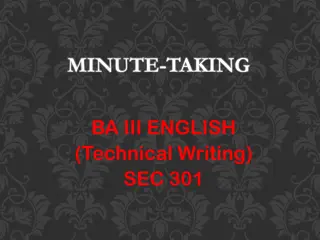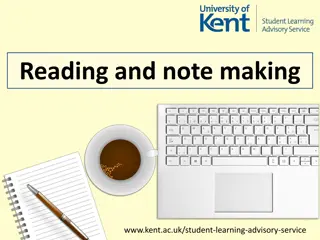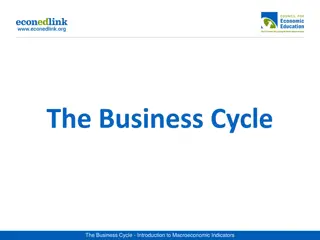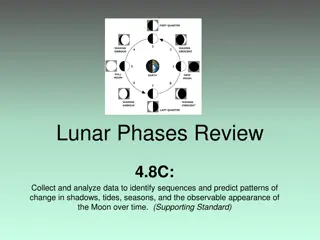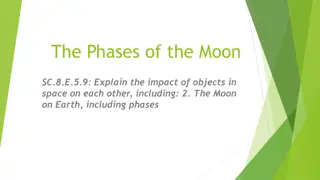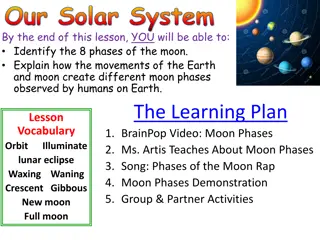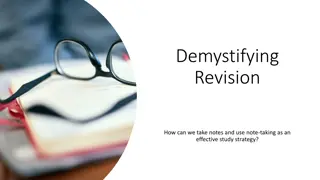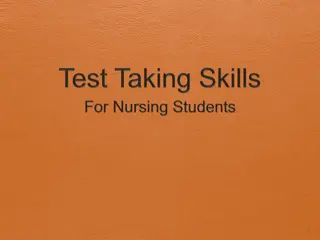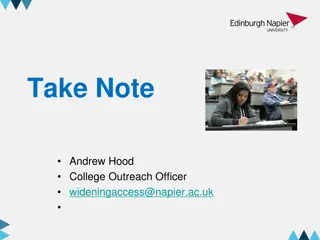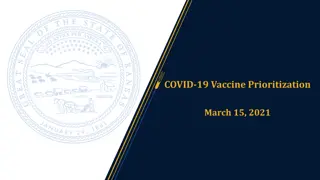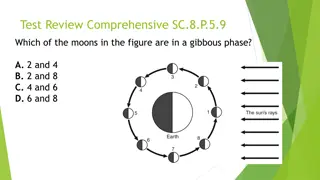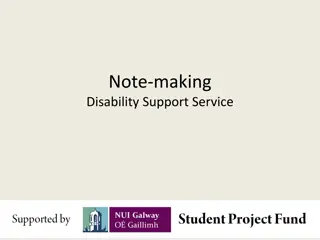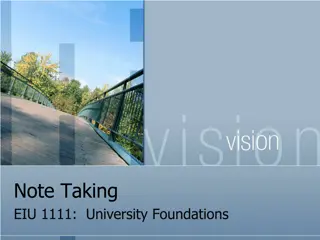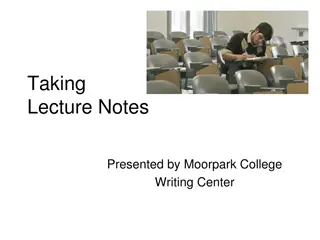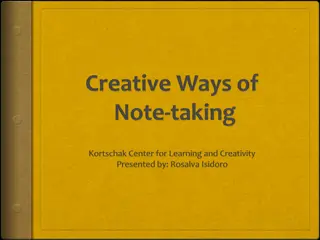Mastering the Five Phases of Focused Note-Taking Process
Explore the essential steps of the focused note-taking process, from taking initial notes to processing, connecting, summarizing, and reflecting on learning. Understand the guiding principles and detailed phases to enhance your note-taking skills effectively.
Download Presentation

Please find below an Image/Link to download the presentation.
The content on the website is provided AS IS for your information and personal use only. It may not be sold, licensed, or shared on other websites without obtaining consent from the author. Download presentation by click this link. If you encounter any issues during the download, it is possible that the publisher has removed the file from their server.
E N D
Presentation Transcript
Focused Note-Taking Five Steps to Success Purpose to demonstrate your understanding of the 5 Phases of the Focused Note-Taking process Slide 1
Focused Note-Taking Process Taking Notes Processing Notes Connecting Thinking Summarizing and Reflecting on Learning Applying Learning Slide 2
Guiding Principles The focused note-taking process must be explicitly taught! For learning to occur most effectively, learners must revisit their notes multiple times in a variety of ways. Every phase of focused note-taking involves inquiry. Learners must constantly ask questions of themselves, their notes, and the content. Slide 3
Focused Focused Note Note- -Taking Taking Phase 1 Phase 1 Taking Notes Establish a purpose & purpose & objective objective for note-taking Select the best format format for the notes Write notes Write notes based on your source(s) Write an Essential Essential Question Question to guide the note-taking Learn to use a variety of formats for different purposes Select, paraphrase, and arrange the information thoughtfully Slide 4
Focused Focused Note Note- -Taking Taking Phase 1 Phase 1 Taking Notes: Formats Two- and Three-Column Notes Mind Maps Output Input Cornell Notes Graphic Organizers Interactive Notebooks Slide 5
Focused Focused Note Note- -Taking Taking Phase 2 Phase 2 Processing Notes Involves thinking about Should be done within 24 hours of taking the notes Provides opportunities for collaboration Will get messy as note-takers revise Focuses on clarifying content and organization about the notes Slide 6
Focused Focused Note Note- -Taking Taking Phase 2 Phase 2 Revise notes by Revise notes by underlining, highlighting, circling questioning deleting classifying, organizing, chunking main ideas less important ideas o details Processing Notes Identify main idea and supporting details by: Selecting Sorting Classifying Organizing Slide 7
Focused Focused Note Note- -Taking Taking Phase 3 Phase 3 Connecting Thinking Think beyond beyond the notes: Ask questions about the notes Add original thinking Wonderment questions Comprehension Prediction Anomaly Detection Application Planning and Strategy Costa s Levels of Thinking Make connections to what you already know content from the course or from outside the course your life or the world around you your note-taking purpose Slide 8
Focused Focused Note Note- -Taking Taking Phase 3 Phase 3 Connecting Thinking Return to the notes with an eye for inquiry: Learning makes sense when it is connected to what we already know, what we ve experienced, or how we can use it. Learners should ask questions they really want to find the answers to and truly want to discuss. Slide 9
Summarizing and Reflecting on Learning Focused Focused Note Note- -Taking Taking Phase 4 Phase 4 What have I learned? What have I learned? Capture the most important aspects of your notes Answer the Essential Question Think about the notes as a whole. Summarize Summarize How will this be useful? How will this be useful? Consider how the learning helps you meet the note-taking objective Plan where you go from here Reflect Reflect Slide 10
Focused Focused Note Note- -Taking Taking Phase 5 Phase 5 Applying Learning Use the notes for their intended purpose. Demonstrate what you ve learned or apply it to a new situation. Socratic Socratic Seminar Seminar Philosophical Philosophical Chairs solving solving Researching Researching Writing Writing Narratives Reports Reports Presentations Presentations Proposals Proposals Speeches Panel Panel Discussions Discussions Project Project- -Based Based Learning Studying Studying Letters Letters Articles Articles Scripts Scripts Documentaries Critiques Critiques Experiments Experiments Blogs Blogs Chairs Debates Debates Problem Narratives Arguments Arguments Essays Speeches Teaching Teaching others Learning Quizzes Documentaries Reviews Dissertations Dissertations Conclusions Problem- - Essays others Tests Reviews Conclusions Quizzes Tests Slide 11
Lets practice the Focused Note-Taking Process! Taking Notes Processing Notes Connecting Thinking Summarizing and Reflecting on Learning Applying Learning Slide 12
Focused Focused Note Note- -Taking Taking Phase 1 Phase 1 TakingNotes Did you write down the note-taking purpose from slide 1? If not, ask an elbow partner! Supplement the notes that you ve already taken by adding notes from the Student Overview Video Slide 13
Focused Focused Note Note- -Taking Taking Phase 2 Phase 2 Compare your notes with a partner and revise by Compare your notes with a partner and revise by underlining, highlighting, circling questioning deleting classifying, organizing, chunking main ideas less important ideas o details Processing Notes Slide 14
Focused Focused Note Note- -Taking Taking Phase 2 Phase 2 Processing Notes Divide your notes into chunks In the left column of your notes, write the Main Idea of each chunk/section of notes Going above and beyond! Using the words/phrases you circled and underlined in each chunk, write a one- sentence synthesis statement Slide 15
Focused Focused Note Note- -Taking Taking Phase 3 Phase 3 Connecting Thinking As a class, think outside the notes think outside the notes by sharing questions and original thinking and writing those in the left column and/or in text. Ask questions about the notes Wonderment questions Comprehension Prediction Anomaly Detection Application Planning and Strategy Costa s Levels of Thinking Add original thinking Make connections to what you already know content from the course or from outside the course your life or the world around you your note-taking purpose Slide 16
Summarizing and Reflecting on Learning Individually write a Summary Reflection at the bottom of your notes. Focused Focused Note Note- -Taking Taking Phase 4 Phase 4 What have I learned? What have I learned? Capture the most important aspects of your notes Answer the Essential Question Summarize Summarize How will this be useful? How will this be useful? Consider how the learning helps you meet the note-taking objective Plan where you go from here Reflect Reflect Slide 17
Focused Focused Note Note- -Taking Taking Phase 5 Phase 5 Applying Learning Use the notes for their intended purpose. Our Purpose to demonstrate your understanding of the 5 Phases of the Focused Note-Taking process We will do this through SYNECTICS! Synectics is the process of making unexpected connections; a form of analogous thinking often used in problem solving; a form of analogy. Slide 18
Focused Focused Note Note- -Taking Taking Phase 5 Phase 5 Applying Learning Explain how the Focused Note-Taking Process is like another process. Creatively demonstrate and present the connection (skit, poster, digital presentation, etc.) For example: create a poster showing how the Focused Note-Taking process is like the process of building a house perform a demonstration of how the Focused Note-Taking process is like learning to properly shoot a jump-shot Slide 19



